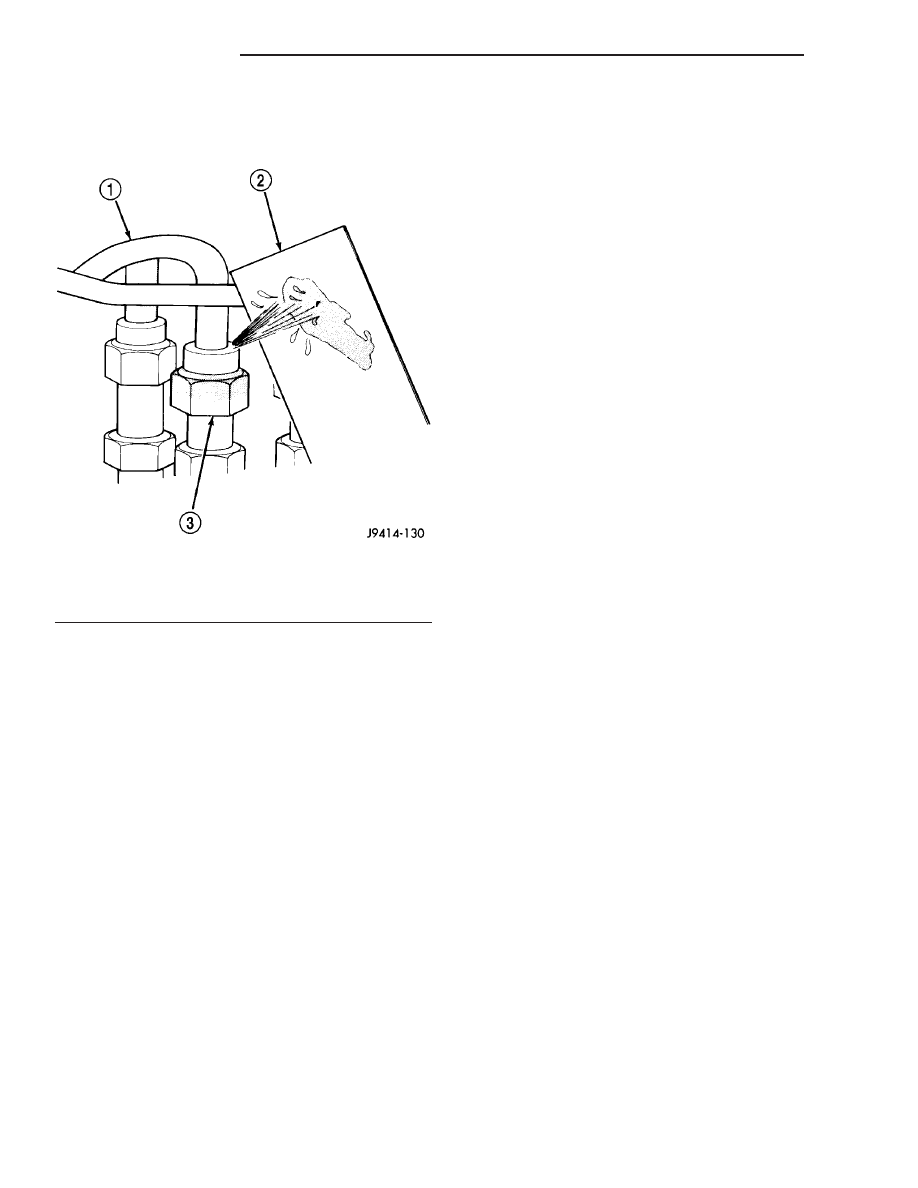Chrysler PT Cruiser. Manual - part 216

FUEL
SYSTEM
-
STANDARD
PROCEDURE).
Replace any damaged, restricted or leaking high-
pressure fuel lines with the correct replacement line.
CAUTION: The high-pressure fuel lines cannot con-
tact each other or other components. Do not
attempt to weld high-pressure fuel lines or to repair
lines that are damaged. Only use the recommended
lines when replacement of high-pressure fuel line is
necessary.
DIAGNOSIS AND TESTING - AIR IN FUEL
SYSTEM
Air will enter the fuel system whenever fuel supply
lines, separator filters, injection pump, high-pressure
lines or injectors are removed or disconnected. Air
trapped in the fuel system can result in hard start-
ing, a rough running engine, engine misfire, low
power, excessive smoke and fuel knock.
Inspect the fuel system from the fuel tank to the
injectors for loose connections (Refer to 14 - FUEL
SYSTEM - WARNING). Leaking fuel is an indicator
of loose connections or defective seals. Air can also
enter the fuel system between the fuel tank and the
fuel pump. Inspect the fuel tank module and fuel
lines for damage that might allow air into the sys-
tem.
With the DRBIII
t connected to the vehicle, select
Engine and the select Sensor Display. Page down to
view Fuel Pressure Set Point and Actual Fuel Pres-
sure. Start the engine and observe the Fuel Pressure
Set Point and the Actual Fuel Pressure. If the Actual
Fuel Pressure Oscillates above and below the Fuel
Pressure Set Point in a regular cycle, inspect the fuel
system for air intrusion.
If the Actual Fuel Pressure gradually drops below
the Fuel Pressure Set Point then spikes well above
the Fuel Pressure Set Point, replace the fuel pres-
sure control valve (Refer to 14 - FUEL SYSTEM/
FUEL INJECTION/FUEL PRESSURE SOLENOID -
REMOVAL), and recheck.
DIAGNOSIS AND TESTING - INJECTOR LEAK
QUANTITY
WARNING: REVIEW THE HIGH PRESSURE FUEL
SYSTEM WARNING BEFORE BEGINNING SERVICE
(Refer to 14 - FUEL SYSTEM - WARNING).
NOTE: If an injector is found to be out of specifica-
tion, repeat this test procedure after the injector
replacement. Hydraulic flow will take the path of
least resistance and multiple failures may be identi-
fied.
Perform this test with the engine at operating tem-
perature. This test will assist in determining a defec-
tive or internally leaking injector(s) is present by
measuring the amount of fuel return.
(1) Turn the ignition off.
(2) Remove the engine cover (Refer to 9 - ENGINE
- REMOVAL).
(3) Disconnect the fuel return hoses at the top of
the injectors.
(4) Disconnect and block off the oil return line at
the banjo bolt fitting of the fuel rail.
(5) Disconnect the fuel rail solenoid.
(6) Install the test vials onto the injectors and
secure with the return hose clips (Fig. 2).
(7) Crank the engine for ten seconds while moni-
toring each inner test vial.
After ten seconds, a maximum of two graduation
lines may be reached. If the level has exceeded the
two graduation line, replace that effected cylinder’s
injector, clear the memory using the scan tool, empty
the test vials, and retest. If the level did not pass the
two graduation line limit, continue to the next step.
(8) Turn the ignition off. Leave the emptied test
vials in place. Reconnect the fuel pressure solenoid.
Disconnect the cam position sensor, crank the engine
for ten seconds.
After ten seconds, a maximum of four graduation
lines of the inner test vial may be reached. If the
level has exceeded the four graduation line, replace
that effected cylinder’s injector, clear the memory
using the scan tool, empty the test vials, and retest.
Fig. 1 Typical Test for Leaks with Cardboard
1 - HIGH-PRESSURE LINE
2 - CARDBOARD
3 - FITTING
14 - 2
FUEL SYSTEM
PT
FUEL SYSTEM - 2.2L DIESEL (Continued)